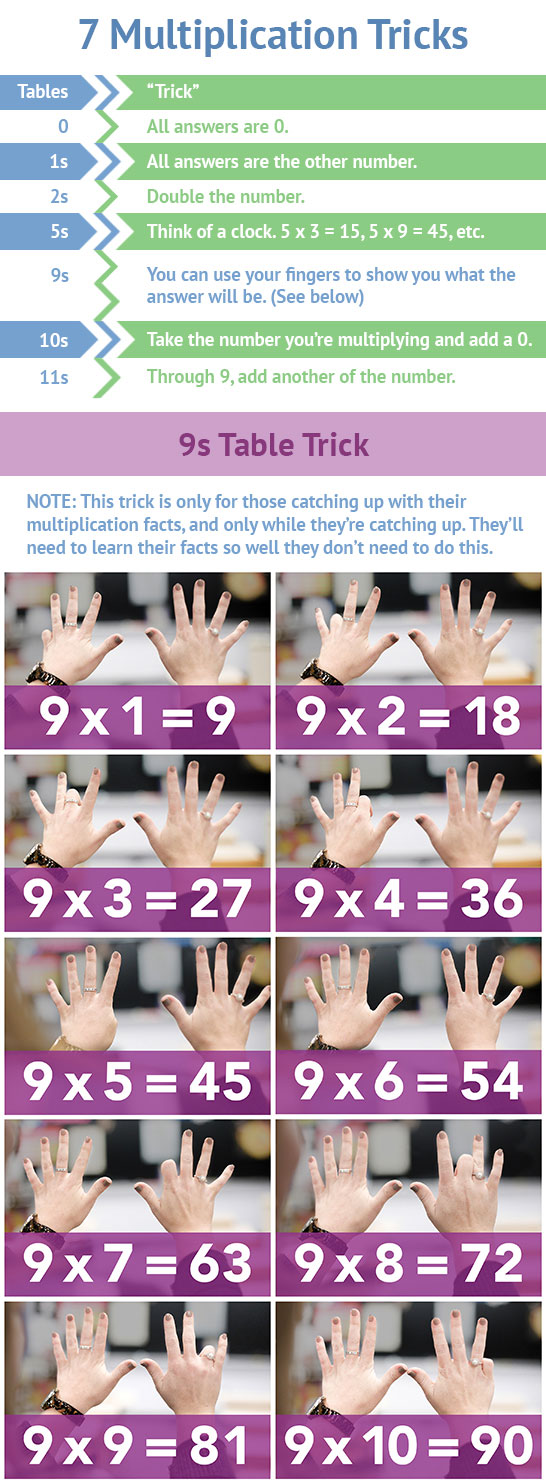Updated March 6, 2020
The number-one reason students dread math is that they haven’t mastered their multiplication facts. When they get to higher-level math, knowing the multiplication tables is fundamental. Learning them, though, isn’t always fun or easy.
We have a few tips for how to tackle teaching multiplication facts to your students with more confidence and less stress.
Teach by Table
You may be teaching several grades, or you may be teaching only one, but one thing is for sure — you will have students who don’t know their multiplication tables. Some are more behind than others.
Where do you start? In either situation, teach one table at a time instead of teaching several at once. This makes the huge undertaking of learning 0 x 0 through 12 x 12 something doable.
It breaks the elephant down into bite-sized pieces. For the zero table, teach 0 x 0, 1 x 0, 2 x 0, etc., through 12 x 0.
The zero table is clear and easy for most students, of course, but don’t skip it! Mastering the 0 table gives students the satisfaction and confidence that comes from learning something new.
Then move on to the next table, teaching from 1 x to 12 x. After your students know tables well, then practice those tables mixed together. Until then, only practice tables separately.
Just as early grades learn to count by 2s, 5s, 10s, and 3s, it’s best to teach the multiplication tables in that order, one at a time. Starting in 2nd grade, you’d start with the 0s and continue in numerical order with all the tables through the 12s.
TIP: The top factor on a card is the table marker. Keep your cards organized by tables to set you up for success and keep you from wasting time. Try Swiffer containers for easy, free storage.
Review and More Review

Repetition is the key to learning multiplication tables, and there’s no way around it. If you want your students to progress, review. If you want to keep track of how your students are doing, review. If you want to see your students ready for the next grade, review.
Does that mean you have to spend half your lesson reviewing? Definitely not. The key to success is more about consistency than duration. Look at your lesson plans to see how long to review and for creative ways of including it.
You may need to spend more time preparing to teach new material, so you’ll have time to review. But it will be worth it. This is one investment you can be certain will pay off.
Simplify

Of the thirteen tables, seven have tricks to make them easier to learn. Isn’t that great? Your students will think so.
Besides tricks, there are also strategies. Don’t leave those out. Teach the concept of twins: the combination looks exactly alike, only the numbers are switched. Students don’t need to learn a new combo—just remember the twin. For example, 6 x 8 is the same as 8 x 6. Point out doubles, too; they’re easier to memorize. A few examples are 5 x 5, 8 x 8, and 9 x 9.
Make it fun!
Just saying the multiplication tables over and over again with no variety would get boring for anyone. Make it fun by playing songs that put the tables to music, or make your own music. The 2s table could be sung like a robot and the 3s with a Texas twang,
Whisper and bend low as you start to say the table. As the numbers get higher, get louder and stand tall. For younger children, walk to the side like a crab.
Clap on the desk between the combinations once, twice, or three times (you decide). For example, 0 x 3 = 0, clap, 1 x 3 = 3, clap. The only limit is your imagination!
Make it fit!
Think of all the time your class spends walking somewhere or waiting to do something.
Practice when you’re going to or coming back from recess, headed to a field trip, or waiting for assembly to start. During waiting periods when class conversations get loud, try redirecting all those voices to multiplication tables. It will sound a lot better, and you’ll be making that time count!
Like so many other developed in the elementary years, multiplication facts are a tool that your students can proficiently learn and use for a lifetime of efficient mathematical application. Even when it seems slow going, don’t get discouraged! If you need help, get in touch with one of our educational consultants by emailing us here, or go to our free online learning to see examples of how it’s done.

Our math program makes a mastery of multiplication possible from elementary to middle school.
SHOP MATH PRODUCTS



Comments for How to Teach Multiplication Facts More Easily
Add A Comment
Your email address will not be published. Required fields are marked *